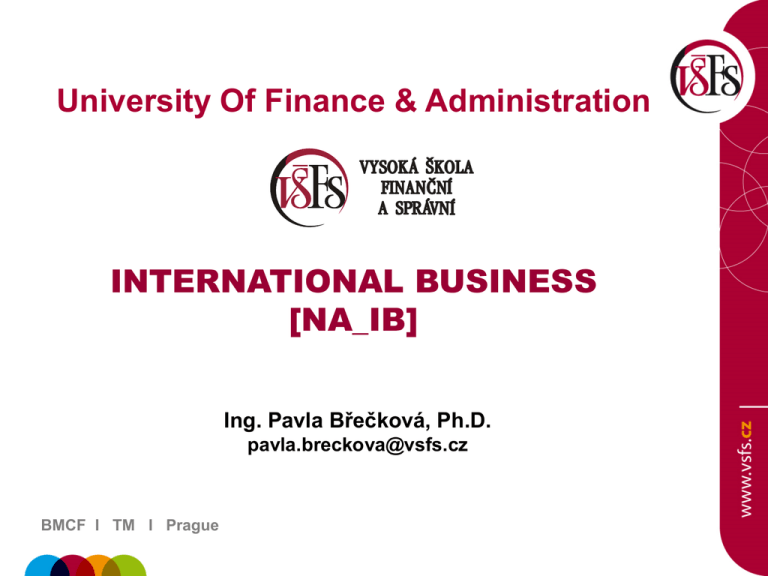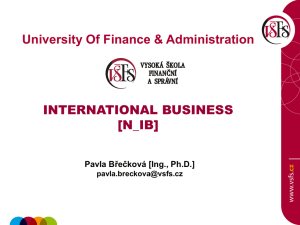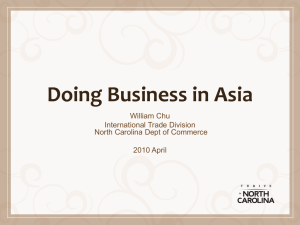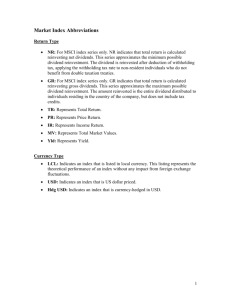international business
advertisement

University Of Finance & Administration INTERNATIONAL BUSINESS [NA_IB] Ing. Pavla Břečková, Ph.D. pavla.breckova@vsfs.cz BMCF I TM I Prague INTERNATIONAL BUSINESS Part-time course = 4 guided consultations á 90 mins. (winter term 2010) 1. GLOBAL BUSINESS ENVIRONMENT & EXPORT + Case study setting 2. WORLD BUSINESS TERRITORIES and EMERGING MARKETS + Case study elaboration 3. INTERNATIONAL TRADE & FDI + prezentation of the Case study results 4. EUROPEAN MARKETS & PREDISPOSITIONS for working in IB + oral exam possible 2. EXAM terms NA_IB 4 lectures / guided consultations [GC] (per 90 mins) Completion: exam / 6 credits Completion CONDITIONS: Active participation in the guided consultations [active listening, discussing, reading, analyzing & interpreting of economic articles or case study results, presence at GC – 50%] Case study elaboration & it’s prezentation Oral exam [prove of knowledge in IB] If unfulfilled: 1. semester elaborated quality paper (methodics in IS – Study materials) 2. and oral or written exam 3. CASE study / team work CASE study on one of these topics: 1. BUSINESS TRENDS / opportunities in the next 10 years Largest threats & opportunities from the point of view of international business, where it (IB) is going. Areas where it is likely to find the business opportunities during next 10 years + explain what brought you to such results. 2. EXPORT STRATEGY Mid term view (3-5 years). What it should lie in, generally - how to support export (of CZ enterprises), concrete forms + in which business and industry areas (if in any / if not in all of them) + explain why 3. Finding the COMPETITIVE ADVANTAGE for the Czech Republic (and of the CZ businesses). Competitive advantage + consequently what areas of business and industry should be preferential (if any) + what to do for succeeding in international business from the point of view of competitive advantage (micro and macro view). Possibly also what kind of business environment (or changes in the present one) would help developing the CZ businesses competitive advantage? CASE study - elaboration CASE study on one of these topics: 1. BUSINESS TRENDS / opportunities in the next 10 years 2. EXPORT STRATEGY 3. Finding the COMPETITIVE ADVANTAGE for the Czech Republic ELABORATION: Elaboration in teams per 3-4 people Presentation of the results - ppt possible, cca 10 min., structured way, clear outcomes (solutions, results) PREZENTATION: - 29/11/2010 - up to 10 min. / all the team members should be involved LITERATURE SOURCES Woods, M.: International business. Basingstoke, Palgrave, 2001. ISBN: 0333-75979-6. Wild, J., Wild, K., Han, J.: International business: the challenges of globalization. 4th ed. – Pearson, Upper Saddle River, 2008. ISBN: 978-013-174743-6. Griffin, R.W., Pustay, M.W.: International business: a managerial perspective. 5th int. ed. - Upper Saddle River, Prentice Hall, 2007. ISBN: 0-13-233532-8 Czinkota, M.R., Ronkainen, I.A., Moffett, M.H.: International business. 7th ed. - Australia. ISBN: 978-981-4246-05-7 PLEASE NOTE: No need to have the literature permanently at disposal during semester 6. GLOBAL BUSINESS ENVIRONMENT Session one is devoted to a discussion of the global context within which IB must function in the 21st century. The aim is to describe the external framework which exists today and which will influence company strategies in the international arena. There are clearly some factors that will be more important than others in determining the likelihood of success in international markets: The state of the world economy and the rules and regulations governing INT trade and investment are critical The political and social environment also impinges on businesses, i.e. consideration of the role of culture in IB / importance of cultural empathy to business success International ENVIRONMENT GLOBAL MACRO MICRO 8. INTERNATIONAL BUSINESS [B_IB] Ing. Pavla Břečková, Ph.D. / 19063@mail.vsfs.cz GLOBAL BUSINESS ENVIRONMENT If a business is to be succesful – it needs to be aware of: the GENERAL ENVIRONMENT – 2 levels of understanding 9. BROAD SPECIFIC = relevant to most companies [includes economy, political, tech. world and sociological issues] = important to the individual business [includes customer / supplier relations, investor requirements, workplace issues] IB OPERATIONS Manufacturing 10. Assembling Distribution Selling Principle of COMPARATIVE ADVANTAGE Absolute advantage = a country has an absolute advantage over it trading partners if it is able to produce more of a good or service with the same amount of resources or the same amount of a good or service with fewer resources (copper, oil) Comparative advantage (David Ricardo 1772-1823) = a country has a comparative advantage in the production of a good or service that it produces at a lower opportunity cost than its trading partners (relativity). = units of production (people/machines) will be employed in those processes in which they are relatively more productive (productivity) Opportunity cost (John Stuart Mill) = is the value of the next-best choice available to someone who has picked between several mutually exclusive choices - opportunity costs are not restricted to monetary or financial costs: the real cost of output forgone, lost time, swag, pleasure or any other benefit 11. GLOBAL BUSINESS ENVIRONMENT Awareness of the GENERAL ENVIRONMENT – 2 levels of understanding 12. BROAD SPECIFIC = relevant to most companies [includes economy, political, tech. world and sociological issues] = important to the individual business [includes customer / supplier relations, investor requirements, workplace issues] Factors at BROAD level of IB understanding – influences on the IB environment FACTORS with SIGNIFICANT INFLUENCES on IB (BROAD level of understanding IB) POLITICAL ECONOMIC • Integration of LDCs and Centrally planned economies into INT economy • Difficulties (& oppo) raised by econ.inequalities • Role of OECD, WTO, World Bank, EU commiss. direction of INT Trade & Investment • Environmental concerns • Economic cycles in 50 years waves: Prosperity Recession Depression Recovery • • INFROMATION & COMMUNICATION wave (1980/90’) driven via NETWORKS (comps, tech based com., production, control systems) • 13. • INT economic agreem. (liberalisated trade & capital flows) => led to establishing REGIONAL ECONOMIC GROUPINGS - 3 main trading blocks TRIAD GATT (1947-95) =>WTO 2 particular issues of Importance for FUTURE: Labour standards Environmental issues TRANSPORTATION TECHNOLOGICAL TRIAD – 3 main world trading blocks NAFTA • • North American Free Trade Agreement USA, CANADA, MEXICO EU • 27 countries ASEAN • • • 14. East & South-East ASIA Indonesia, Malaysia, Philippines, Singapore and Thailand from 1967 Brunei, Burma (Myanmar), Cambodia, Laos and Vietnam TRIAD – NAFTA NAFTA member states • FREE TRADE AREA • From 1994 • Population: 457 million Density: 25.1/km2 • GDP/capita: 35,490 USD • Water 7.4% 15. TRIAD – EUROPEAN UNION EU member states • Economic UNION • GDP / capita: 39.729 USD • Population: - 501 million - density: 115.9/km2 • Water 3.08% 16. TRIAD – ASEAN ASEAN • Free Trade Area • GDP / capita: 5,131 USD • Population: 600 million (8.8% of world population) - density: 135/km2 17. WORLD BUSINESS Features / consideration: – – – – – 18. Dollar / Euro ZONE Business Culture Law enforcement Business Barriers Business threats / opportunities WORLD BUSINESS CHALLENGES Few challenges which will need to be faced by business if expanding their international operations: • increased competition arising from a greater freedom of world trade • changing distribution of economic activity across the globe • acceptance of changes in corporate structures in order to match the strategic changes required to survive the global marketplace 19. WORLD BUSINESS possible PROSPECT The interesting QUESTION [from an economic perspective] is what the above means for the future: • the 19th century was dominated by Great Britain and Europe as colonial powers • the 20th century by the USA as the great economic power • the 21st century will be controlled by Asia, and China in particular 20. ECONOMIC INTEGRATION Economic (monetary) & Political union Common market Customs union Free trade area 21. 21. ECONOMIC INTEGRATION Description I. Free Trade Area: Type of trade bloc, a designated group of countries that have agreed to eliminate tarrifs, quotas and preferences on most (if not all) goods and services traded between them. It can be considered the 1st - 2nd stage of economic integration (Preferential trading area) Customs union Composed of a Free Trade area with a COMMON EXTERNAL TARIFF. The participants set up common external trade policy, but in some cases they use different import quotas. Purposes for establishing a customs union normally include increasing econ. efficiency + establishing closer political and cultural ties between members It is the 3rd stage of economic integration 22. ECONOMIC INTEGRATION Description II. Common / Single market A single market is a type of trade bloc which is composed of a FTA (for goods) with common policies on product regulation, and FREEDOM of MOVEMENTof the FACTORS OF PRODUCTION (capital, labour) and of enterprise and services. The physical (borders), technical (standards) and fiscal (taxes) barriers among the member states are removed to the maximum extent possible. These barriers obstruct the freedom of movement of the four factors of production. To remove these barriers the member states need political will and they have to formulate common economic policies. A common market is a first stage towards a single market, and may be limited initially to a free trade area with relatively free movement of capital and of services, but not so advanced in reduction of the rest of the trade barriers. Economic union 23. Type of trade bloc which is composed of a common market with a customs union. The participant countries have both common policies on product regulation, freedom of movement of goods, services and the factors of production and a common external trade policy. EXPORT What is? – when you trade something out of the country. In economics, an export is any good or commodity, transported from one country to another country in a legitimate fashion, typically for use in trade. Why to aim to world business territories? Why export is good for economy / country? EMERGING MARKETS What is an emerging market? – – – – – Emerging markets are nations with social or business activity in the process of rapid GROW and INDURSTRALIZATION. Currently, there are 28 emerging markets in the world, with the economies of CHINA and INDIA considered to be by far the two largest. The ASEAN–China Free Trade Area, launched on January 1, 2010, is the largest regional emerging market in the world. An emerging market economy (EME) is defined as an economy with low to middle per capita income. • Such countries constitute approximately 80% of the global population, and represent about 20% of the world's economies. The term was coined in 1981 by the World Bank. One key characteristic of the EME is an increase in both local and foreign investment (portfolio and direct). A growth in investment in a country often indicates that the country has been able to build confidence in the local economy EMERGING MARKETS [EM] entering Special problems related to entering EM – Lack of information (problematic data collection) EM’s market-potential analysis: – – – – – – – – Market SIZE Market INTENSITY – estimates wealth, buying power Market GROWTH rate – GDP, energy consumption etc. Market CONSUMPTION CAPACITY – spending capacity (% of middle class, core of buying power) Commercial INFRASTRUCTURE – chanels for com./distrib. Economic FREEDOM – free market principles domination Market RECEPTIVITY – market ‘openness’ Country RISK – of doing business VIETNAM • • • • • • • 80 million people est. 1945 division into 2 parts (Hanoi / Saigon – Ho Chi Minh City) Vietnam war 1963 – 73 Member of ASEAN Elements of free trade principles Dynamically developing VIETNAM VIETNAM + • competitive advantage: persistence, hardworking, humility • education – better avg.in south Asia (no illiteracy) • not developed country but growing rapidly (7-8%) • relations (1/4 million of V.studied in CZ – backbone of V.economy) 29. • bad infrastructure • no history and exp. in industry / engineering • corruption • QM missing => low VA industries, no experience • business culture (no longterm relations / businesses) • very low law enforcement • not fully liberalised envi VIETNAM Business doing – Patience, long meetings / negotiations – No long contracts – chaos: changing mind, no reliability in European understanding (effort to satisfy) – No business drive in Euro perception (enq./offers – lengthy via email) – Personal contacts necessary / local – No win-win (‘loss of face’ danger) – Business cards handling – ‘YES’ even if meant NO CHINA CHINA + • hard-working • education – in towns and industry areas • no-VA parts (or normalised) very cheap • massive gov. investments in infrastructure • railways net / HSR (but due to industrialization too busy) 32. • rising prices • only large series / payments in advance • control (necessity of Chinese citizen in the business) - not fully liberalised envi • quality instability (no sustainable Q) • fractionalism • no ENVI issues / labour conditions CHINA Business doing – – – – – Smiles not usual in business Nepotism, preference of family members Patience – time to succeed Seniority respect Double check of mutual understanding / samples precision etc. – Contract – precision (parameters, samples – signed etc.) TAIWAN TAIWAN – Republic of China – Capital: Taipei – Population: 23 million - Density: 668 /km2 TAIWAN + • extremely hard-working • good knowledge of English (EU/USA education) • industrial tradition (cca 30 years) • no-VA parts (or normalised) very cheap • flexibility & professional approach (enq./ sampling / quality) • ISO norms not a formality • good infrastructure: airport / HSR • fully free market 36. • raw materials import – dependence on China • changing EUR / USD • status manipulation + pretending “made in Taiwan” (PRC reality) • frequent typhoons (supplies postponing) TAIWAN Business doing – – – – – – Professional, very polite Business cards handling Quick response / sticking on agreed Willingness to sort out the claims No need to double-check understanding In machine production – taking shoes off in offices – Strong green teas at business meetings INDIA INDIA – Capital: New Delhi / largest: Mumbai – Language: Hindi, English – Population: 1,118,521,000 - Density: 361 /km2 - GDP per capita: 3,100 USD INDIA + - • good education, English • distinctive ability • bank sector highly developed • secluded economy (extremely high import taxes) • large market with over 1mld. people / growing purchasing power • changing EUR / USD • productivity 40. INDIA Business doing – English – Demanding negotiations, long (several hours) – Half-truths common – Compromise necessary (Indian bargaining) + keep the positions (manipulation resistance) – Agreements – sticking on INTERNATIONAL BUSINESS - BMCF / TM - winter term 2010 Thank you for your attention Ing. Pavla Břečková, Ph.D. pavla.breckova@vsfs.cz





